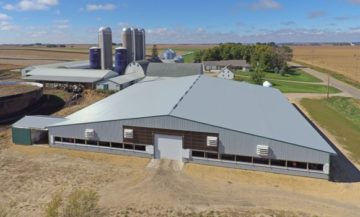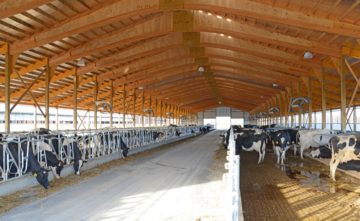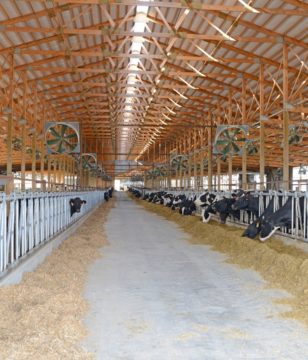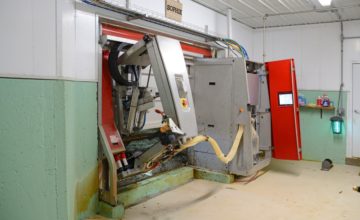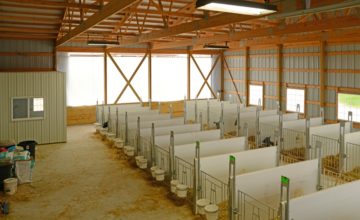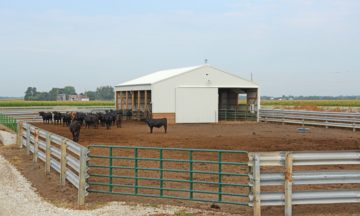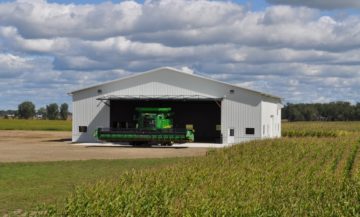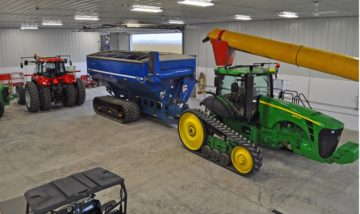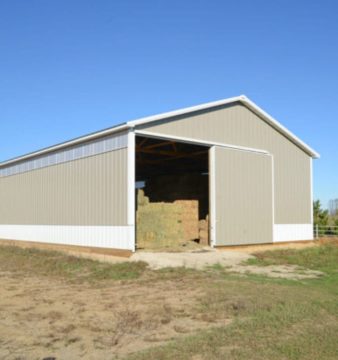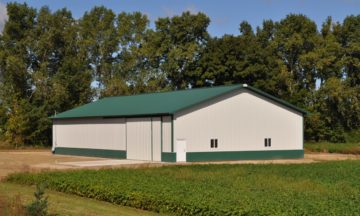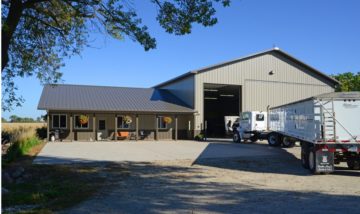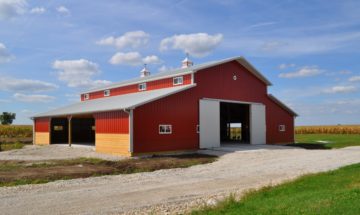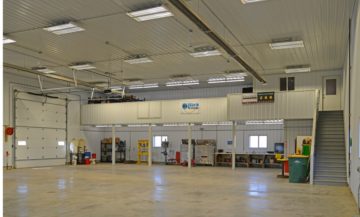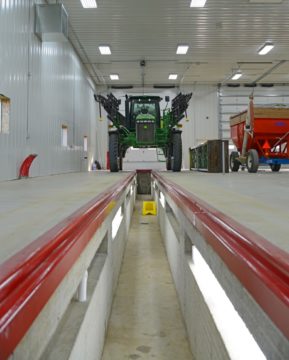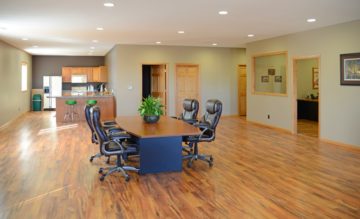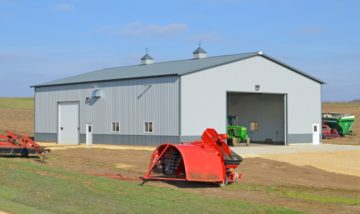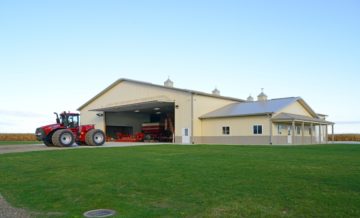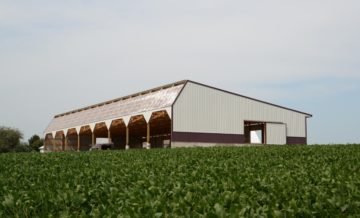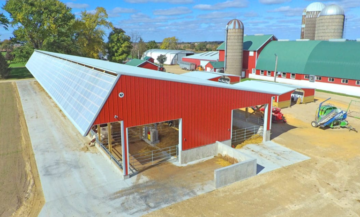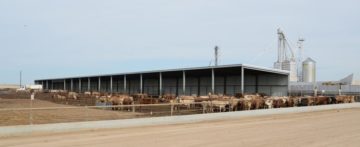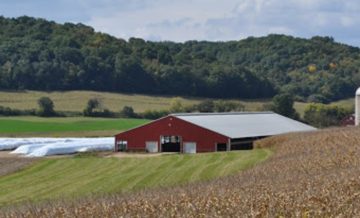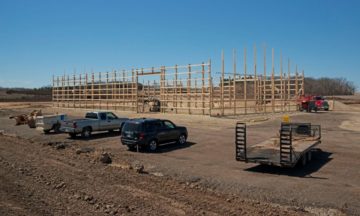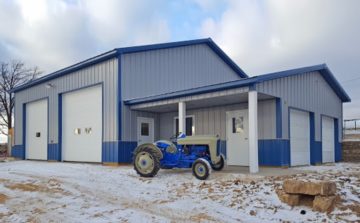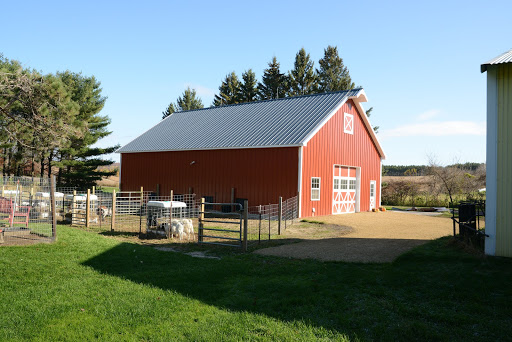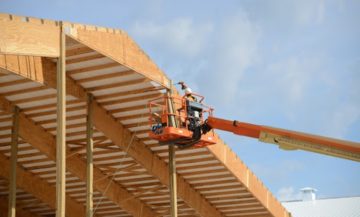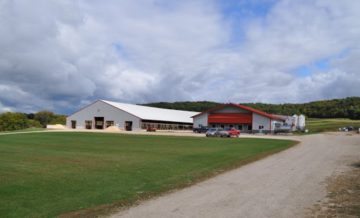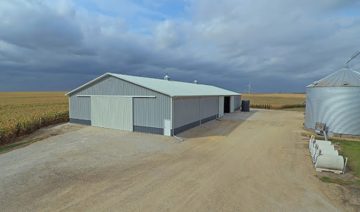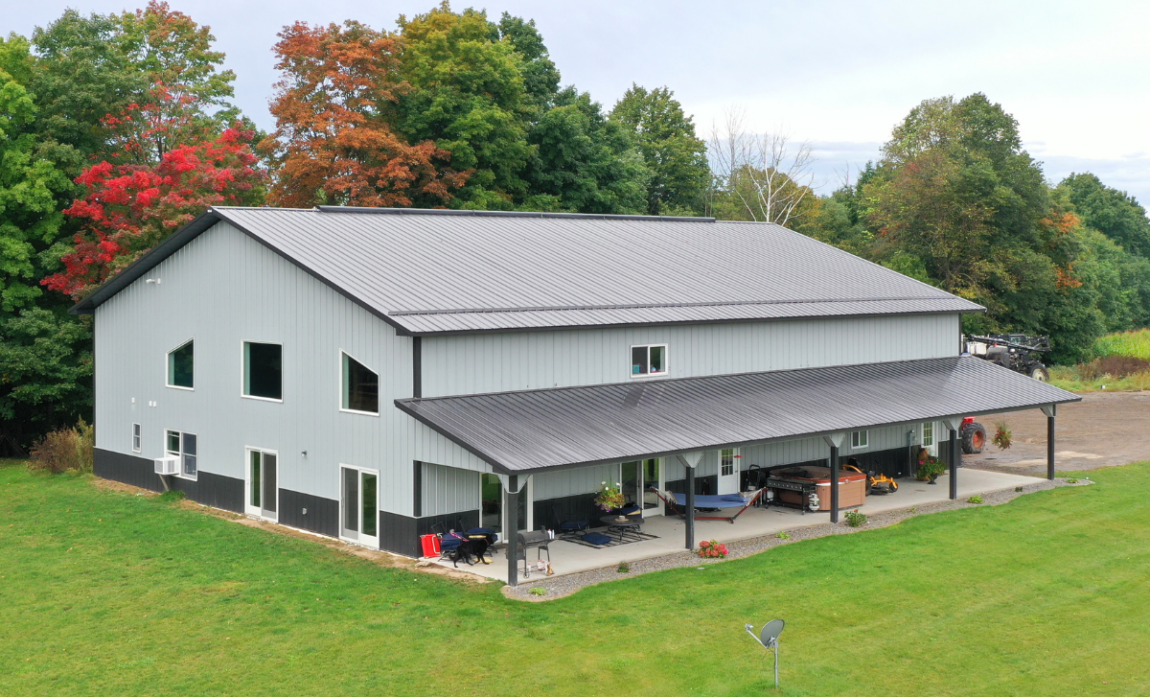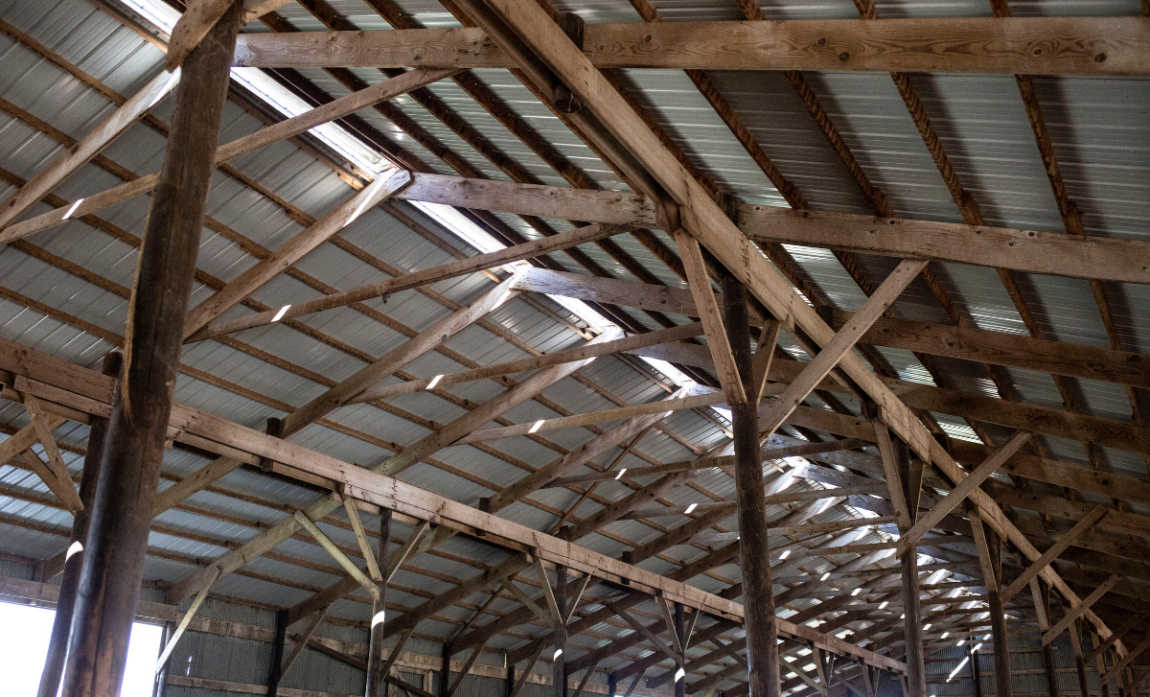Remember when a barn was just … a barn? Sure, those were simpler times, but today people demand a lot more from their farm buildings. Fortunately, a post-frame building, commonly known as a pole barn, is a flexible and economical way to handle a wide range of agricultural needs.
Post-frame builders use highly engineered laminated wooden posts and strong trusses that, among other benefits, transfer wind and snow loads to the foundation and allow for expansive, unobstructed interior spaces. Just the kind of features that work great for farm buildings.
The 33 ideas we share below all relate to post-frame structures. And to help you visualize your next farm building, we also provide lots of helpful example photos. Click on the links below to jump to specific ideas:
Dairy Barn Ideas
Animal Confinement Ideas
Equipment & Large Implement Storage Ideas
Crop Storage Ideas
Multi-Use Farm Building Ideas
Pole Barn Door Ideas
Sunlight Control Ideas
Pole Barn Construction Ideas
Dairy Barn Ideas
A lot goes into fostering a healthy and productive dairy herd. One major factor is the type of building you use to house your milking cows. Pole barns can be constructed to keep cows comfortable and protected. They also can take on many forms, such as the following, to meet your specific dairy demands:
- Freestall
- Milking parlor
- Maternity barn
- Solar barn
- Manure processing/separating facility
Maximize the width of your space to accommodate a large dairy herd
A large dairy herd demands lots of space. A post-frame approach can help you maximize the width of your agricultural building. Widths of 110 feet or more are possible.
Use sidewalls to improve ventilation and install fans
A freestall pole barn like the above can provide cows a cleaner, more comfortable resting and feeding area, while it also protects them from the elements. Plus, to improve ventilation, side walls can manually be raised up or pulled down depending on the weather, and fans can easily be strategically placed throughout the building.
Use wide lanes to make feeding time easier
A post-frame building allows for wide lanes like this, which can make feeding time a much smoother process for both you and your cows. Removing manure and transferring cows is also made simpler.
Attach a milking parlor to your pole barn
This enclosed milking parlor attached to a freestall pole barn creates a more convenient milking process.
Animal Confinement Ideas
Pole barns can be designed and built efficiently to create a healthy environment for youngstock, beef cattle, sheep, swine, and poultry.
Use curtain walls to keep youngstock comfortable and protected
This pole barn makes a great space for calves. Note the curtain walls, which serve as adjustable openings to prevent humidity and reduce drafts.
Give livestock an escape from the summer sun
Use an open air pole barn like this for confining heifers or other livestock. This solar style freestall area affords cows an escape from the summer sun. A structure like this not only provides shade but also maximizes air flow to keep cows comfortable. (See below for more on sunlight-related features.)
Create easy access to the outside
Fencing or gating can easily be built off of your animal confinement pole barn, allowing livestock convenient access to the outdoors.
Equipment and Large Implement Storage Ideas
From large tractors and huge farm implements like combines to a long list of smaller supporting machinery – they all need sufficient storage to lengthen their lifespan and protect your investment.
A lot of this equipment requires high ceilings, tall, wide doors, and lots of clear-span space. These happen to be hallmark features of post-frame buildings.
Enjoy a cost-effective way to have extra-large doors
Pole barns allow for a cost-effective way to have wall openings for large doors. That’s because post-frame structures use on-center spacing of 8 or more feet.
This is much larger than what would be possible in a typical stick-frame construction, which would require using expensive headers and framing reinforcements. See below for more on doors.
Fit more in a large garage or storage shed
The wide open expanses that are possible in a post-frame building make it easier to store more machinery in a limited space.
Add office space conveniently
Adding an office or residence space onto your machine shop can be more cost effective with post-frame construction. This is true whether you do it as part of the original project – or as an addition later (a good reason to allow room for expansion). See more on creating a multi-use pole barn below.
Crop Storage Ideas
Pole barn structures are great for reliable crop storage.
Protect hay, feed and crops more effectively
Pole barns can serve as excellent weathertight buildings to store hay, straw, and feed, and to keep crops protected long after harvest time.
Use taller doors for easier access
A pole barn can be engineered for easy access and optimal work efficiency. Taller door openings, for example, make it easier to offload, store, and load hay and similar items.
Multi-Use Farm Building Ideas
Agriculture comes with a variety of demands. Pole barns are a flexible building option that can handle that variety – whether you need a storage building, a machine shop, a working office area (with a kitchenette!), or even a combo of all of them.
Make it a place for a variety of work
Note the differently sized large door openings on this pole barn – plus the added porch overhang and office space.
Add features to enhance both form and function
Cupolas like those found on the top of this multi-use pole barn allow for better ventilation and provide a great aesthetic touch.
Include a mezzanine and office space in your machine shop
Because post-frame construction uses larger membered clear-span wood trusses, you can have wider open spaces without interior support walls. Factors like that help create a machine workshop such as this one, which even includes an upper level office space and a mezzanine for additional storage.
Protect equipment more effectively with a concrete floor
A concrete floor like this one will reduce moisture and help keep your equipment better protected.
Add a mechanic’s work trench
Your pole barn storage shed or machine shop can have features like this mechanic’s work trench, which makes repairs and maintenance on your equipment a lot easier.
Include a simple (or elaborate) office space
Depending on your needs and your budget, you can include a simple office space or a more elaborate one like this, which includes a kitchenette, a conference table, a bathroom, and a large separate office.
Now that you’ve seen ideas on the possibilities for agricultural pole barns, here are additional insights to improve their performance and help make them last longer.
Pole Barn Door Ideas
For the large door openings typically needed for an agricultural building, there are three common types of doors—sliding, overhead, and hydraulic.
Use sliding doors for greater cost-effectiveness
Sliding doors are the most cost-effective. They can either be one-piece (like the one on the left in the photo above) or split in the middle (like on the right, same photo). Thanks to improvements in tracks and trolleys and the use of lighter materials, sliding doors are much easier to open and close than back in the day.
Be sure to check out Which Type of Door is Best for Your Pole Barn? to learn more about pole barn doors.
Enjoy the convenience of an overhead door for frequent use
An overhead door opens upward on a track like a common garage door, though an overhead door on a pole barn will likely be larger. This type of door is more expensive than a sliding door, but it’s relatively cost-effective for a door you’ll be using regularly.
Move extra-large equipment in and out easily with a hydraulic door
Hydraulic doors are large, heavy-duty doors that swing open and can work great for hauling big pieces of equipment in and out of buildings.
Sunlight Control Ideas
In the past, fiberglass resin panels were used to allow light in. But they yellowed and became brittle when exposed to UV rays, resulting in cracking and leak points. Enter the use of polycarbonate, a much more UV-resistant material that’s also more durable in general.
Take advantage of polycarbonate panels for multiple uses
When engineered correctly into your agricultural pole barn building, polycarbonate panels have multiple applications:
- Animal housing
- Machine sheds
- Maintenance shops
- Grain drying
Use polycarbonate panels for year-round sunlight control
In addition to being more durable, polycarbonate panels can work in conjunction with the seasons, allowing far-reaching sunlight into the structure in the winter and keeping the interior shaded – and cooler – in the summer.
Learn more about the benefits of polycarbonate material by checking out Polycarbonate Leading a Solar Resurgence in Post-Frame Construction.
Pole Barn Construction Ideas
The inventory, equipment, and animals inside your pole barn might be worth hundreds of thousands or even millions of dollars. At the end of the day, investing in a durable structure up front will help ensure that things remain safe and that your structure can stand the test of time.
Here are key ways to help make sure you have a reliable building for many years to come:
Make sure the building is properly engineered
A reputable building company with construction standards designed by licensed professional engineers is a good first step.
A smart pole barn builder who is attuned to your building’s intended use will situate your building appropriately. For example, a level site is instrumental for the construction crew to build your structure easily and efficiently.
Closely related, every site should include a solid drainage system and other features that prevent moisture from infiltrating your building in the first place.
Use high-quality materials
Don’t be tempted to skimp on quality building materials for your pole barn project. Lumber, steel, doors, and windows – these are the four most important materials involved in building a post-frame structure. And they all can vary widely in their quality.
Hire a good crew
A good crew understands the engineering behind a building’s design and will adhere to the specific guidelines set by the designer. If they don’t, the building’s durability will suffer.
For more information on creating a more lasting pole barn, check out 5 Ways to Build Agricultural Buildings With Durability in Mind.
Design a building that factors in the worst conditions
In general, good structural design takes Mother Nature into account. But for an ag building in particular, factors like the following need to be reflected in the design and construction:
- Humidity
- Snow loads
- Exterior temperature
- Indoor building temperature
- Wind
Use materials of known strength and durability
For a building to be properly engineered, you need to know how strong your materials are.
For example, to resist applied loads, you need to know the lumber’s bending, shear, and axial strengths. Or if you’re worried about potential hail damage, you should choose thicker roof steel and possibly a steel with a higher yield strength.
Be sure to use proper bracing during construction
The fact is that more agricultural building failures occur during construction than after. What’s the biggest culprit? Not bracing properly for inclement weather.
For more information on this topic, take a look at Why Do Some Agricultural Buildings Fail to Withstand Inclement Weather?
Use proper ventilation
While lumber and steel comprise the majority of your structure, ventilation features can play a significant role in your building’s performance. Installing a good ventilation system is smart for any structure, but it’s absolutely vital in agricultural buildings, especially those holding livestock.
When lots of congregating animals expel urine and manure, or even breathe, they create a lot of moisture. If this moisture builds up inside your structure, it can deteriorate the wood and steel, and over time it can loosen the fasteners where materials meet.
A well-designed ventilation system helps get rid of moisture, keeping the outside and inside of the building in optimal condition. Moreover, it cycles fresh air through your building, which is better for the animals living inside – as well as the people who may be spending a lot of time in it.
Learn the essentials on pole barn ventilation by checking out Pole Barn Ventilation: How to Achieve Good Air Quality in Your Post-Frame Building (And Why It’s So Important).
Help air flow with smart venting
We’ve already touched on this important pole barn factor above. In essence, you can help combat condensation by moving the wet air out through natural ventilation. But that “natural” process needs to be helped with strategically calculated (and placed) ridge and eave venting.
Identify possible interior sources of moisture
Your pole barn design should take into account the potential sources of moisture that will be produced inside the building. In addition to livestock, here are some other common examples:
- Fill dirt
- Poor drainage
- High groundwater table
- Unvented heaters
- Snow melt from vehicles or washing vehicles
- Firewood, green lumber, or fresh cut timber
- Hay
- Open grate pits or sumps with water
To gain more insights on preventing condensation, be sure to read How to Prevent Condensation Under a Metal Roof: The Enemy Within.
Choose proper insulation
Let’s stay on the condensation topic and focus on ideas for using insulation (or for not using insulation). The traditional method for preventing moisture from condensing on the underside of a pole barn’s metal roof is to insulate it.
But there are simpler, more economical alternatives. First, just know that you may not need to insulate your entire building, especially if you plan to use your pole barn for animal confinement.
More specifically, you may not need wall insulation because the animals themselves can generate a lot of heat. In that case, you can use insulation under the roof only.
Or, you could use a DripStop membrane under the roof, an option that can actually save you thousands of dollars. It accomplishes condensation control like insulation does, but without the additional material and labor costs.
Want more details about insulation for your pole barn? Check out How to Insulate Your Pole Barn: 5 Tips to Prevent Heat Loss and Gain, AND Optimize Your Building’s Performance.
So Much Depends on Designing Carefully and Building Correctly
All too often, agricultural buildings aren’t designed and constructed with the care and precision they really deserve. Choosing a pole barn option for your agricultural needs is a smart first move. Just be sure you take steps to ensure you’ll have a great performing pole barn building for years to come.

